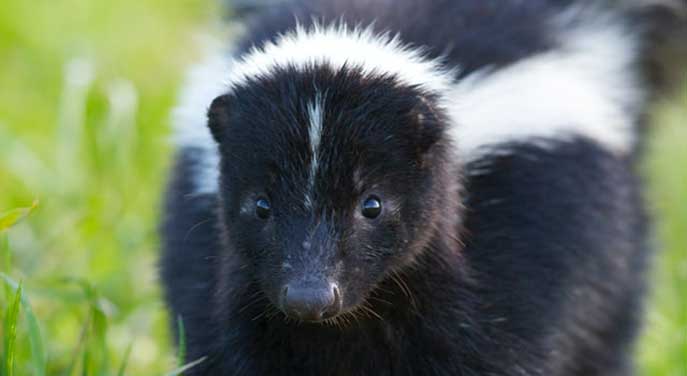 Ask almost anyone what they think of skunks and their nose will curl up and they’ll frown.
Ask almost anyone what they think of skunks and their nose will curl up and they’ll frown.
I kind of like the smell. Don’t get your knickers in a knot – personal preferences are, well, personal!
So why don’t we explore the life of these common, but maligned, mammals?
But before we do … although I’ve always thought the smell of a skunk’s musk to be unique, I find that from time to time I now get confused.
A while back the Canadian government legalized the use of marijuana in Canada. When it’s smoked it has a distinctive smell but when it’s being grown it smells almost exactly like a skunk. I’ve found myself looking around for this little black and white creature when I should have been looking for pot growers.
A member of the weasel clan, skunks share DNA with otters, wolverines, martens, mink, ferrets, fishers and badgers. All mustelids (i.e. weasels) are known as fierce and unrelenting hunters, since they often pursue prey much greater in size than themselves.
Of the 12 species of mustelid in Canada, the skunk is the most anomalous. Its behaviour, appearance and hunting style are very different than the others.
 First, it’s shaped differently. It’s kind of chubby and waddles when it walks due its wide stance and broad body. It holds its tail stiffly behind it as it walks slowly in a shuffling manner. There’s nothing stealth-like about this critter, but it’s always on the ready for an interaction with potential foes or food.
First, it’s shaped differently. It’s kind of chubby and waddles when it walks due its wide stance and broad body. It holds its tail stiffly behind it as it walks slowly in a shuffling manner. There’s nothing stealth-like about this critter, but it’s always on the ready for an interaction with potential foes or food.
Its eyesight is very poor and it relies on its sense of smell to detect prey and predators.
Found in North America, the striped skunk (mephitis mephitis, as it is correctly known), is a medium-sized weasel, with a total length of 54 to 77 cm (21 to 30 inches), and the tail makes up about 30 percent of that.
Skunks seem to disappear in late fall as they enter a state of torpor in the winter and spend much of the period denned up, often in family groups.
Usually shortly after Christmas, a few males stir and come out for a pee and a look around, but they soon return to the safety and warmth of the den. In late February they emerge in earnest. The females don’t seem to be part of this mid-winter outing.
Mating takes place soon after they emerge in the early spring and by early May about six (with a range of two to 10) babies are born. Born helpless, the kits can’t see or hear, and certainly can’t use their musk glands to ward off intruders. However, by the age of 30 days, they’re good to go.
The skunk has two glands, located on each side of the anus, that create their odorous emissions. Through narrow tubes, the musk is pressurized and can be expelled through papillae over a distance of 3.5 to five metres.
Many dog owners can attest to the pungency and persistence of this malodorous defence mechanism.
It’s widely reported that a skunk can’t spray if its tail can’t be raised, but I wasn’t able to find any good documentation to prove this, so it’s best not to test this theory.
What I did find out is that the chemical structure of the musk is complex and is comprised of thiols (i.e. mercaptans), made up of hydrogen and sulphur.
There are three thiols in the striped skunk’s musk but there are also three types of thioacetates. The latter don’t have a strong scent but can acquire one if combined with water. So when you bathe your pet after a skunk encounter, it actually can smell worse after you clean it.
Don’t use tomato juice to clean that pet – that’s an urban legend that doesn’t work. Scientists report that a concoction made up of a litre of three percent hydrogen peroxide, a teaspoon of liquid soap and a quarter cup of baking soda works effectively. But be forewarned this may dye hair or fur.
To avoid being sprayed, watch for the signs: foot stomping, hissing and tail raising.
The skunk family stays together throughout the summer into the fall, and it’s not uncommon to see a small family group foraging on a lawn or open space. True omnivores, they eat everything (e.g. bird and turtle eggs, small mammals, etc.), but prefer insect prey. If you have white grubs or Japanese beetles in your lawn, expect a visit from these little fellows.
Next time you see a skunk, stand back and marvel at its defensive ability and breathe in the pleasant aroma!
Geoff Carpentier is a published author, expedition guide and environmental consultant. Visit Geoff on LinkedIn, Instagram and Facebook. For interview requests, click here.
The views, opinions and positions expressed by columnists and contributors are the authors’ alone. They do not inherently or expressly reflect the views, opinions and/or positions of our publication.
© Troy Media
Troy Media is an editorial content provider to media outlets and its own hosted community news outlets across Canada.


